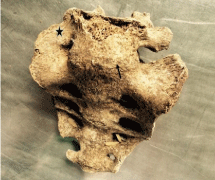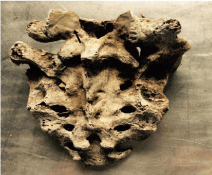
Case Report
Austin J Anat. 2017; 4(2): 1066.
Sacralization of Fifth Lumbar Vertebra- A Case Report
Shetty AS1 and Jetti R2*
1Department of Anatomy, Yenepoya Medical College, Yenepoya University, India
2Department of Basic Medical Sciences, College of Applied Medical Sciences, King Khalid University, Saudi Arabia
*Corresponding author: Jetti R, Department of Basic Medical Sciences, College of Applied Medical Sciences, King Khalid University, Guraiger-3665, Saudi Arabia
Received: January 27, 2017; Accepted: February 16, 2017; Published: February 20, 2017
Abstract
During the osteology demonstration session for medical undergraduate students, we have observed a sacrum with sacralisation of fifth lumbar vertebra. The sacrum had six vertebrae with five pelvic sacral foramina. The body of fifth lumbar vertebra was completely fused with first sacral vertebra. The transverse process on the right side was broad and totally fused with ala of sacrum, whereas left side transverse process was not fused with ala. On the posterior aspect, the inferior articular facets of fifth lumbar vertebra were fused with superior articular facets of first sacral vertebra. From this observation, we conclude that, this is a unilateral sacralisation of fifth lumbar vertebra. Since sacralisation is strongly associated with low back pain, the present case is of high clinical value for medical personnel.
Keywords: Sacrum; Sacralisation; Lumbarisation; Lumbosacral transition vertebra
Introduction
The lumbosacral spine transmits the upper body weight to the lower limbs, thus plays a vital role in posture. Anatomical variations of lumbosacral region include change in the number of sacral vertebrae by fusion of fifth lumbar vertebra or first coccygeal vertebra or deletion of first sacral vertebra [1]. Lumbosacral transitional vertebrae are congenital anomalies of lumbosacral spine, which includes sacralisation of fifth lumbar vertebra or lumbarisation of first sacral vertebra. The incidence ratio of sacralisation to lumbarisation was reported as 2:1 [2]. Sacralisation is classified in to bilateral and unilateral, in bilateral there is a bony fusion between transverse process of fifth lumbar and sacrum on both sides; whereas unilateral the fusion is on either right or left side only. It is also classified into complete and incomplete; in complete sacralisation there is complete bony fusion between the abnormal transverse process and sacrum. In case of incomplete sacralisation there will be a well-defined joint line between the transverse process and sacrum [3]. In case of lumbarisation the first sacral vertebra fails to fuse with second one the individual appears to have six lumbar vertebrae. On the other hand, in sacralisation the last lumbar vertebra fuses with first sacral vertebra the person appears to have four lumbar vertebras [4].
Bertolotti is the first one to report sacralisation, in which the transverse process of fifth lumbar vertebra is large and fused with sacrum or ilium or both. This is observed in 3.6% to 18% of the population [5].
Case Presentation
During the osteology demonstration session of sacrum for medical undergraduate students, we have noticed a sacrum with sacralisation of fifth lumbar vertebra. The sacrum belongs to adult male; the precise age was unknown.
On examination of anterior view of sacrum, it had six vertebrae with five pelvic sacral foramina, the last lumbar vertebral body was fused with the first sacral vertebra. The transverse process on right side was large and fused with the ala of the sacrum. However transverse process on left side was usual size and did not fuse with the ala of sacrum (Figure 1). On posterior view of sacrum, the inferior articular facets of fifth lumbar vertebra were fused with superior articular facets of first sacral vertebra (Figure 2). All the other features of the sacrum was normal.

Figure 1: Anterior aspect of sacrum; arrow denotes complete fusion of L5
with S1; star denotes complete fusion of right transverse process with ala
of sacrum.

Figure 2: Posterior aspect of sacrum; arrow shows the fifth lumbar vertebra.
Discussion/Conclusion
The incidence of sacralisation varies with race. Its incidence is 11.1% in Gujarati population [1]. It is found to be 4% in Chinese population, 8.1% in British population, 10% in Arabs, 16% in Indians and 14% in central India, 18% in Australian aboriginals and 35.9% in Turkish population [6-11].
Castellvi classified lumbosacral transitional vertebra in to four morphological types, in type I the transverse process is dysplastic with width more than 19mm. Type II is characterized by incomplete sacralisation or lumbarisation with unilateral or bilateral enlarged transverse process and there may be a pseudoarthrosis between transverse process and adjacent sacral ala. In type III there will be complete lumbarisation or sacralisation with complete fusion of transverse process with sacral ala. Type IV is a mixed variety, for eg. It may be of type II on right side and type III on left side. All these types are further classified in to unilateral or bilateral varieties [12]. In view of these types the present case has its place in type III unilateral variety.
The basis for lumbosacral transitional vertebra is related to its embryological development. Embryologically each vertebra is developed from the contributions from caudal half of one sclerotome and cranial half of the succeeding sclerotome. The cartilage between fifth lumbar and first sacral vertebrae may undergo calcification that results in sacralisation.
Sacralisation in females causes difficulty in labour due to less mobile pelvis because of fusion of lumbosacral joint. It may be reason for low back ache [1]. Sacralisation may cause Bertolotti syndrome which is characterized by low back ache. Pressure on nerve trunks, ligamentous sprain, soft tissue compression, Arthritis of a joint and bursitis (if joint and bursa is present). Sacralisation may be one of the causes for lumbar disc herniation as lumbosacral transition vertebra is a weight bearing are repeated flexion/extension movements may stress the superior disc space that’s why lumbar disc herniation most commonly occurs above the level of lumbosacral transitional vertebra [5]. Sacralisation may lead to a complication of spondylolisthesis [4]. It might compress fifth lumbar nerve that results in pain along the distribution of sciatic nerve [3]. Some congenital anomalies like this is helpful in identification of a person during medicolegal investigations, especially when antemortem records are available or when the skeletal remains are brought in for examination [13].
Knowledge of sacralisationis important for all the medical personnel, hence the present case and its clinical importance has been discussed.
References
- Dharati K, Nagar SK, Ojaswini M, Dipali T, Paras S, Sucheta P. A study of sacralisation of fifth lumber vertebra in Gujarat. National Journal of Medical research. 2012; 2: 211-213.
- Olofin MU, Noronha C, Okanlawon A. Incidence of lumbosacral transitional vertebrae in low back pain patients. West Afr J Radiol. 2001; 8:1-6.
- Moore BH. Sacralization of the fifth lumbar vertebra. J Bone Joint Surg Am. 1925; 7: 271-278.
- Castellvi AE, Goldstein LA, Chan DP. Lumbosacral transitional vertebrae and their relationship with lumbar extradural defects. Spine. 1984; 5: 493-495.
- Bertolotti M. Contributto alla conoscenza dei vici di differenzarione regionale del rachide con speciale riguards all asimilazzione sacrale della v. lombare Radiologique Medica. 1917; 4: 113-144.
- Hsieh CY, Vanderford JD, Moreau SR, Prong T. Lumbosacral transitional segments: classification, prevalence, and effect on disk height. J Manipulative Physiol Ther. 2000; 7: 483-489.
- Brailsford JF. Deformities of the lumbosacral region of the spine. British Journal of Surgery. 1929; 64: 562-627.
- Bustami F. The anatomical features and functional significance of lumbar transitional vertebra. Jordan Med J. 1989; 23: 49-59.
- Sharma VA, Sharma DK, Shukla CK. Oesteogenic study of lumbosacral transitional vertebra in central India region. Journal of Anatomical Society of India. 2011; 2: 212-217.
- Mitchell GA. The significance of lumbosacral transitional vertebrae. British Journal of Surgery. 1936; 93: 147-158.
- Erken E, Ozer HT, Gulek B, Durgun B. The association between cervical rib and Sacralization Spine (Phila Pa 1976). 2002; 15: 1659-1664.
- Gadekar S, Parmar J, Vikani S, Vaishnani H, Gujaria IJ, Shah GV. Study on sacralisation of lumber vertebra. Indian Journal of Applied Basic Medical Sciences. 2013; 15: 118-124.
- Kanchan T, Shetty M, Nagesh KR, Menezes RG. Lumbosacral transitional vertebra: clinical and forensic implications Singapore. Med J. 2009; 2: 85-87.